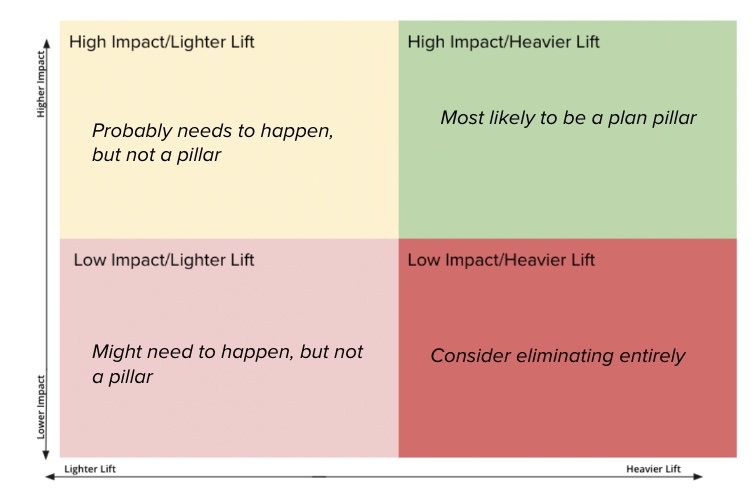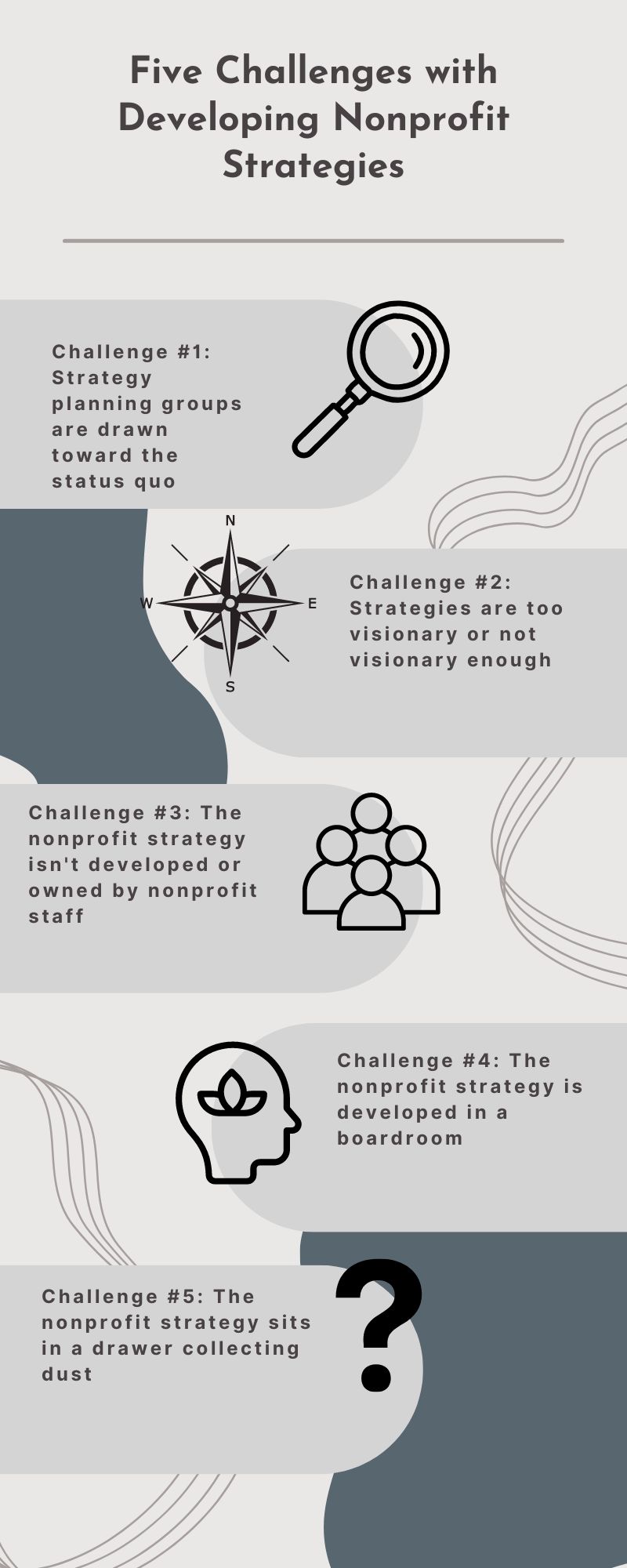At Prosper Strategies, there’s nothing we love more than supporting organizations in creating bold, new nonprofit strategies. But, that’s not to say the process isn’t rife with challenges. Following, we’ve outlined some common challenges, which you may have seen us talk about before, and we also provide ideas for how to overcome them. These are challenges so common, that we see at least some of them come up with every nonprofit we work with.
Challenge #1: Strategy planning groups are drawn toward the status quo
Most nonprofit strategy planning groups start out with bold aspirations, a desire to break the mold and do big things over the next three to five years. Then, they get into the process of visioning for the future, reviewing what it would take to get there and establishing priorities. Finally, when the rubber meets the road, they learn what they already know: change is hard. So, consciously or not, they start to walk back their boldness as they come to terms with how hard it’s going to be to achieve it. This isn’t an overt conversation, like “let’s just keep doing more of what we’re doing,” rather it happens through a series of conversations and questions that eventually lead the group right back to where they started, where it’s comfortable.
So how do you overcome the gravitational pull of the status quo? In several ways:
- First, agree that your new plan will consist of only net new strategies. Anything that is already part of your day-to-day work or that’s a carry over from a past strategy needs to work its way into your operational plan rather than your strategy.
- Second, allow ample time for visioning without guardrails. This means setting aside conversations about staffing, funding, operational inefficiencies, etc. and spending time simply envisioning around, “wouldn’t it be great if…”
Challenge # 2: Strategies are too visionary or not visionary enough
Allowing ample time for visioning without guardrails, however, brings us to challenge number 2, where strategies are either too visionary or not visionary enough. The best plans strike a balance between ambitious but achievable strategies. How can your nonprofit strike this balance? By focusing on net new strategies, and discussing them through the lens of how much effort they take and how much mission impact they will drive. This means after (and only after) you’ve spent time envisioning your ideal future (again, this is a future without limitations), do you begin having discussions about the reality of your organization.
At Prosper Strategies, we do a few things during this phase of planning to help our clients strike this balance. We:
- Brainstorm all of the questions we’d need to answer to achieve this vision or ideal future state, and then we group them into categories, such as: fundraising, culture, brand awareness, succession planning.
We review each category and discuss whether answering the questions within it would require a net new strategy or not. For the categories and questions where a new strategy is required, we use the Eisenhower Matrix to facilitate a discussion about whether or not the category should make it into the new strategy.

By focusing on net new strategies, and then discussing how much mission impact versus effort they will take to achieve, we can start to identify the strategies that will be bold, but also within reach.
Challenge 3: The nonprofit strategy isn’t developed or owned by nonprofit staff
This challenge typically comes into play under two circumstances. The first is when a consultant is heavily involved in the strategy process and drives the inputs (read: tells you what should be in your plan), the second is when the board is heavily involved in the strategy process and drives the inputs.
While consultants certainly bring expertise and perspective, they shouldn’t be directing the content of your nonprofit strategy. Why? It’s not their strategy to execute. The same goes for the board. It’s the board’s role to drive the strategic direction of the organization, but not to decide how that strategic vision is executed on a daily basis.
So how do you create a plan that is driven by nonprofit staff but has the appropriate buy-in the board?
First, ensure that any consultant you work with is dedicated to facilitating the process, not determining its final contents. Second, clearly define project roles for the board, staff, stakeholders, funders, etc.
Challenge #4: The nonprofit strategy is developed in a boardroom
When nonprofit’s develop their strategies in a boardroom, it’s akin to corporations developing new products or services without the input of consumers – yet it happens all the time in the nonprofit world. Leadership, staff and sometimes board members huddle in a room, conduct a SWOT analysis and get planning, without context for what’s going on in the ecosystem or what their stakeholders want and need. I will acknowledge, engaging stakeholders often doesn’t happen because it takes more time and more effort, but if you do, it will most certainly be transformative.
If you follow Prosper, you know we’ve developed our Shared Power StrategyTM philosophy, which advocates for involving your nonprofit stakeholders, but particularly those you serve, not just in the beginning of the planning process, but throughout every phase. You can do this at the onset of strategy development through conversations, interviews, surveys and focus groups, but you can also continue to engage folks to provide insights as your strategies launch. The most leading-edge organizations are also creating feedback loops to keep stakeholders engaged and informed beyond strategy development into execution, demonstrating how their feedback informs the work.
Challenge #5: The nonprofit strategy sits in a drawer collecting dust
Yup, it happens. Nonprofits spend so much time thinking big, developing strategies, gaining alignment, narrowing their priorities, only to find after all of that work, their plan collects dust in a drawer or file folder somewhere in their office. Why? Because the plan wasn’t designed to be revisited daily, weekly and monthly.
To ensure the strategies you choose are actually actionable, set Objectives and Key Results (OKRs) to articulate exactly what needs to be done to successfully achieve the strategy and how you’re going to measure it.
There you have it, five common challenges in nonprofit strategy development and how to overcome them. What have we missed? Share your challenges in comments below and perhaps we’ll write a future post to discuss how you can overcome it.
